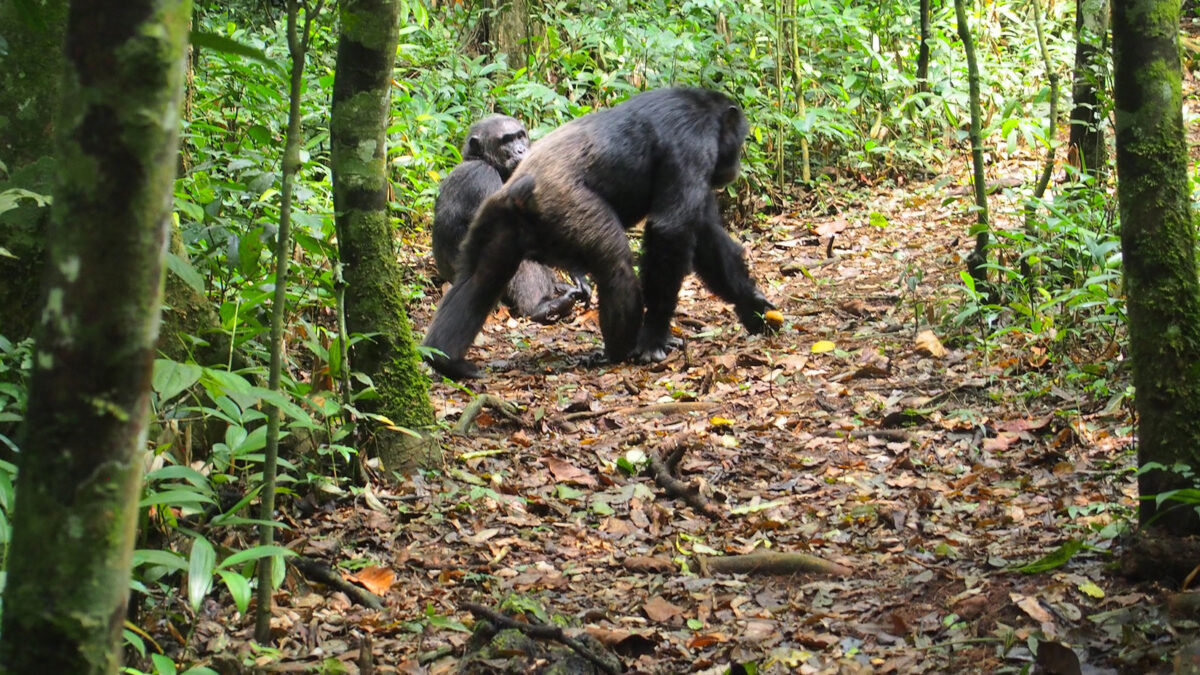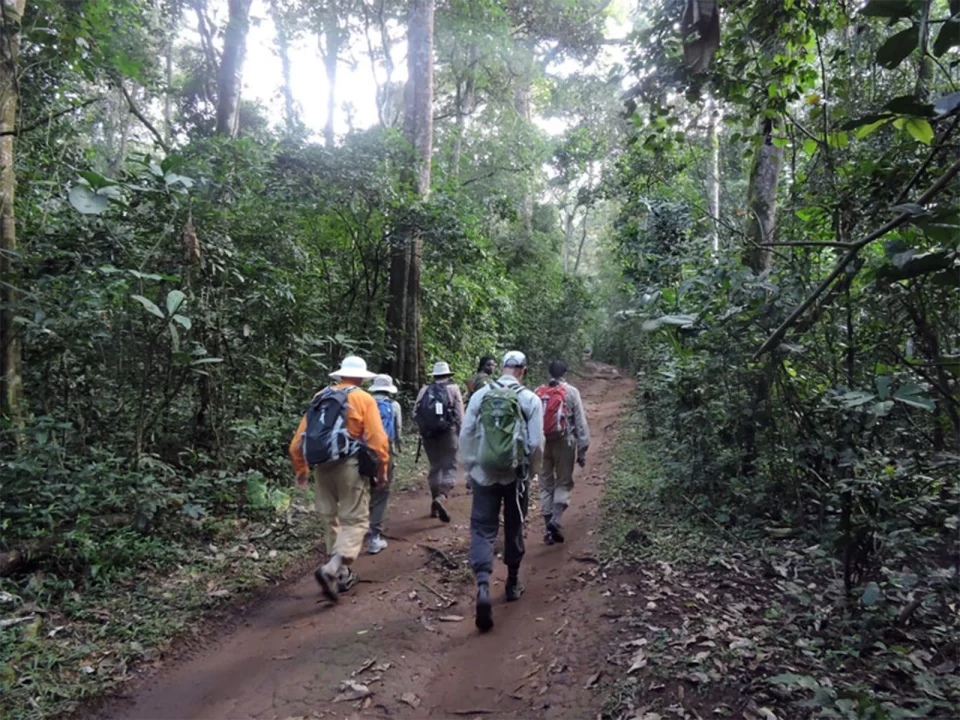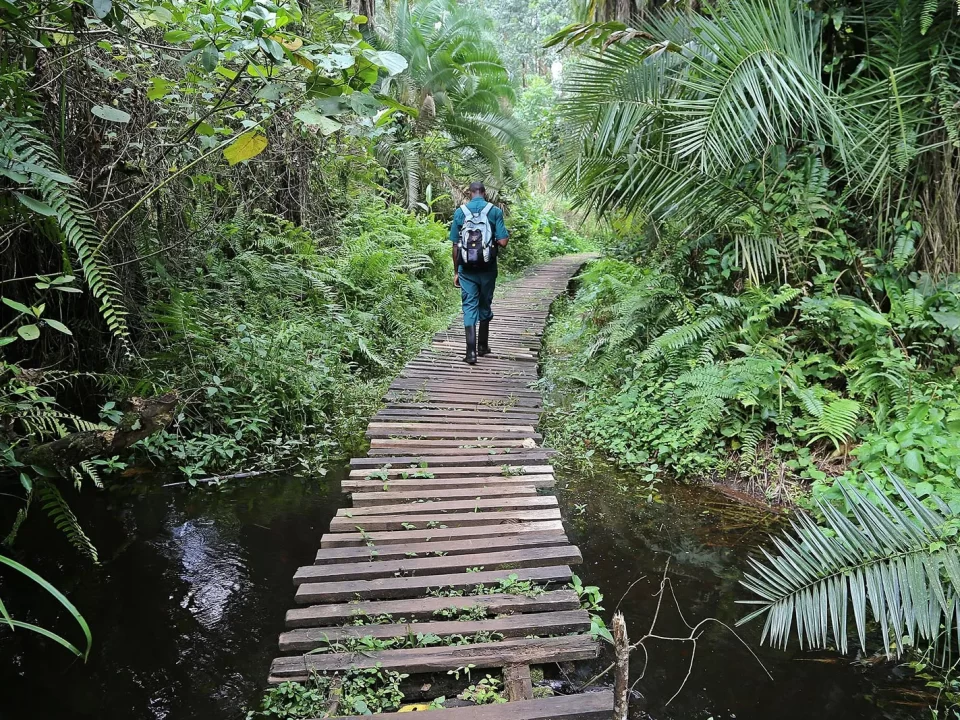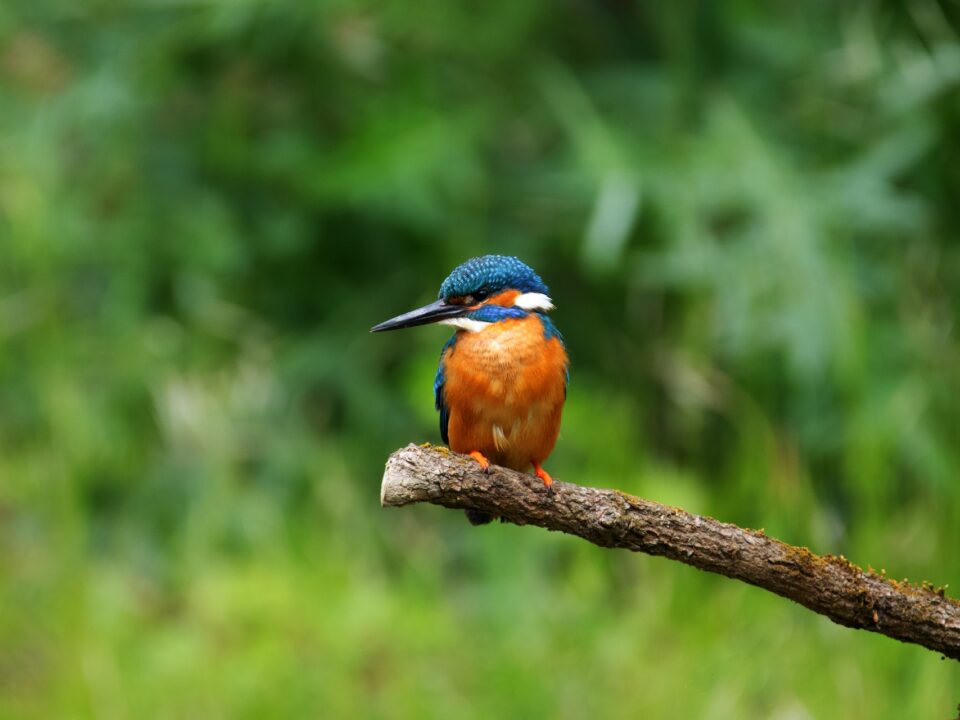Activities and Attractions in Kibale Forest National Park

Albertine Rift Endemics in Rwenzori National Park
September 13, 2023
Luxury Wildlife Safaris In Rwanda
September 13, 2023Exploring Activities and Attractions in Kibale Forest National Park – Unveiling the Wonders of Uganda’s Lush Wilderness
Kibale Forest National Park, a jewel in Uganda’s conservation crown, is a realm of diverse ecosystems and captivating attractions that beckon nature enthusiasts from around the globe. Its geographical landscape is a testament to nature’s artistry, with altitudes varying from the park’s lofty northern tip at 1,590 meters above sea level to its lowest point at 1,100 meters within the Albertine Rift Valley to the south. Within this enchanting forest, a remarkable tapestry of 351 tree species has been documented, some of which soar to towering heights of over 55 meters, with ages exceeding two centuries. Kibale’s elevational diversity gives rise to distinct habitats, ranging from the lush wet tropical forest on the Fort Portal plateau to woodlands and savannas gracing the rift valley floor.
Kibale Forest is not only a natural wonder but also a hub for scientific research. While the park garners significant attention for its chimpanzee populations, numerous other research endeavors explore various facets of Kibale’s ecosystems, including wild pigs and fish species. This blend of biodiversity and scientific exploration creates a captivating backdrop for visitors eager to immerse themselves in Uganda’s wilderness.
Chimpanzee Habituation: A Thrilling Journey into the Wild
One of the most thrilling activities in Kibale Forest is the Chimpanzee Habituation Experience. This adventure allows visitors to venture deep into the forest alongside researchers and habituators, offering a unique opportunity to observe chimpanzee groups less accustomed to human presence. Witnessing these remarkable creatures in their natural habitat is an exhilarating and challenging experience.
The Chimpanzee Habituation Experience is available for both full-day and half-day excursions, and advance booking is essential. Early risers are rewarded with the chance to observe chimpanzees as they depart from their overnight nests between 6:00 and 6:30 a.m. The day unfolds with a symphony of activities, from feeding, copulating, and hunting to breastfeeding, resting, patrolling, and displaying, culminating in nest-building around 7:00 p.m. To secure your slot at the appropriate time, various local tour operators accredited by the government provide services, including booking for the Chimpanzee Habituation Experience.
Chimp Tracking and Beyond
Chimpanzee tracking is among the most sought-after activities in the park. Guided chimp-tracking excursions depart from Kanyanchu and provide an opportunity to encounter these charismatic primates. While chimp sightings are not guaranteed, the chances of spotting them have significantly improved in recent years, with success rates hovering around 90%. The chimpanzee community centered around Kanyanchu is well-habituated, allowing visitors to approach these fascinating creatures from close quarters. During your forest trek, you’re likely to encounter at least two or three other primate species, notably the grey-cheeked mangabey and red-tailed monkey. The forest’s vibrant avian community fills the air with songs, though spotting these elusive birds deep within the forest can be challenging. For bird enthusiasts, the forest camp and roadsides offer better opportunities for birdwatching.
Guided Forest Walks
One of the highlights of any visit to Kibale Forest is the chimp-tracking experience departing from Kanyanchu twice daily, at 8:00 a.m. and 2:00 p.m. While chimp sightings cannot be guaranteed, the odds have improved significantly in recent years, with success rates reaching approximately 90%. The chimpanzee community, with its home base at Kanyanchu, is well accustomed to human presence, allowing visitors to approach them closely. In addition to chimpanzees, you can expect to encounter other primate species, such as the grey-cheeked mangabey and red-tailed monkey. While birdwatching enthusiasts may hear an abundance of birdsong, spotting birds within the forest’s depths can be challenging. You’ll have a better chance of observing birds around the forest camp and along the roadsides. Knowledgeable guides will also introduce you to medicinal plants, bird calls, and animal tracks during your walk.
For devoted chimp enthusiasts and aspiring researchers seeking field experience, consider a full-day habituation experience that involves staying with the chimpanzees throughout the day alongside habituators, taking notes on their behavior. Another intriguing option is a guided night walk with spotlights, available from 7:30 p.m. to 10:00 p.m. daily, offering excellent chances of spotting nocturnal primates like bushbabies and pottos.
Bigodi Wetland Sanctuary: Where Conservation Meets Community Impact
The Bigodi Wetland Sanctuary, nestled adjacent to Bigodi trading center just beyond the national park’s boundary, stands as a shining example of conservation and community development intertwining to create a positive impact at the grassroots level. Managed by the Kibale Association for Rural and Environment Development (KAFRED), the sanctuary channels all proceeds from its trail into community projects in Bigodi. These efforts have funded projects such as a local library and the construction of a new secondary school in the village.
A guided 4.5-kilometer circular trail through the swamp is not only one of the finest bird trails in East Africa but also offers a genuine chance to encounter up to six different primate species within a few hours. The trail commences at the KAFRED office on the Fort Portal side of Bigodi, where visitors are assigned knowledgeable guides. Serious birdwatchers can specify their interests, as some guides excel in bird identification. For those without field guides and binoculars, it’s advisable to ensure that your guide is equipped. Afternoon walks officially start at 3:00 p.m. and usually last around three hours. However, dedicated birders may require more time, making an early start recommended. For morning walks, arriving at the office as early as possible or arranging a dawn start a day in advance is beneficial. Portions of the trail can be quite muddy, so if you lack appropriate footwear, renting gumboots from the KAFRED office is advisable.
The sanctuary’s primary allure for ornithologists lies in the quality rather than the quantity of species. Although you may not identify more than 40 species on a single walk, many of them are forest-fringe and swamp specialists, with a good number representing West African species at the eastern extremity of their range. The greater blue turaco is a standout bird frequently encountered by visitors. Another highlight is the papyrus gonolek, often heard before it’s seen and commonly spotted along the main road as it crosses the swamp or from the wooden walkway approximately halfway along the trail.
Butterflies abound in the swamp, and it’s also home to sitatunga antelope, serval, various mongoose species, and most of the primate species recorded in the forest. The red colobus monkey is a common sight and often observed up close. Additionally, you may spot the red-tailed monkey, L’Hoest’s monkey, black-and-white colobus, and grey-cheeked mangabey. Lucky visitors might even catch a glimpse of chimpanzees, who occasionally visit the swamp to forage for fruit.
Unguided Explorations and More
While tourists are prohibited from walking along forest paths or in Magombe swamp without a guide, unguided walks are allowed in other areas. Kanyanchu itself offers several hours of exploration. The camp hosts a colony of Viellot’s black weavers, and flowering trees attract an array of forest sunbirds. Expect to encounter various types of robins and greenbuls, although distinguishing them can be challenging without a close view. The camp boasts a specialty: the red-chested paradise flycatcher, known for its stunning appearance and distinctive call.
Other intriguing birds often sighted at Kanyanchu include the great blue turaco, hairy-breasted barbet, black-necked weaver, and black-and-white casqued hornbill. The camp’s self-guided grassland trail encircling the area is ideal for observing monkeys. While it’s permitted to walk unguided along the stretch of the main road between Fort Portal and Kamwenge as it passes through the forest, the first few kilometers northward from Kanyanchu offer the most exciting sightings. Here, you’re nearly guaranteed to encounter various monkey species, authentic forest birds like Sabine’s spinetail, blue-breasted kingfisher, and Afep pigeon, as well as swarms of butterflies congregating around puddles and streams. The road south from Kanyanchu to Bigodi traverses diverse habitats, including forest patches, swamps, and grasslands, offering excellent bird and monkey viewing opportunities.
Sebitoli and the Kihingami Wetlands: Hidden Treasures in the North
Sebitoli, nestled within the northern sector of Kibale Forest National Park, is a relatively lesser-visited gem, despite its convenient location just a stone’s throw from the Fort Portal-Kampala road. This area is more accessible than Kanyanchu and provides a similar range of activities and facilities, with the notable exception of chimpanzee tracking, which is not offered here. Guided forest walks at Sebitoli offer a high likelihood of encountering red colobus and black-and-white colobus monkeys, as well as blue and vervet monkeys. Birdwatchers will appreciate the opportunity to observe a diverse selection of the park’s expanding bird checklist, which currently boasts 236 species. While chimpanzees are present in the area, they are not habituated for tourism.
Visitors to Sebitoli can also partake in guided walking or cycling tours to the nearby Kihingami wetlands, located just outside the park. These tours offer exceptional birdwatching experiences and provide insights into local tea estates. They are available daily, and Trek Africa Expeditions can help arrange all your activities and attractions in Kibale Forest National Park.
Embark on an unforgettable journey into Kibale Forest National Park and discover its extraordinary activities and attractions, where nature, research, and community development seamlessly intersect to create a harmonious and captivating environment.




